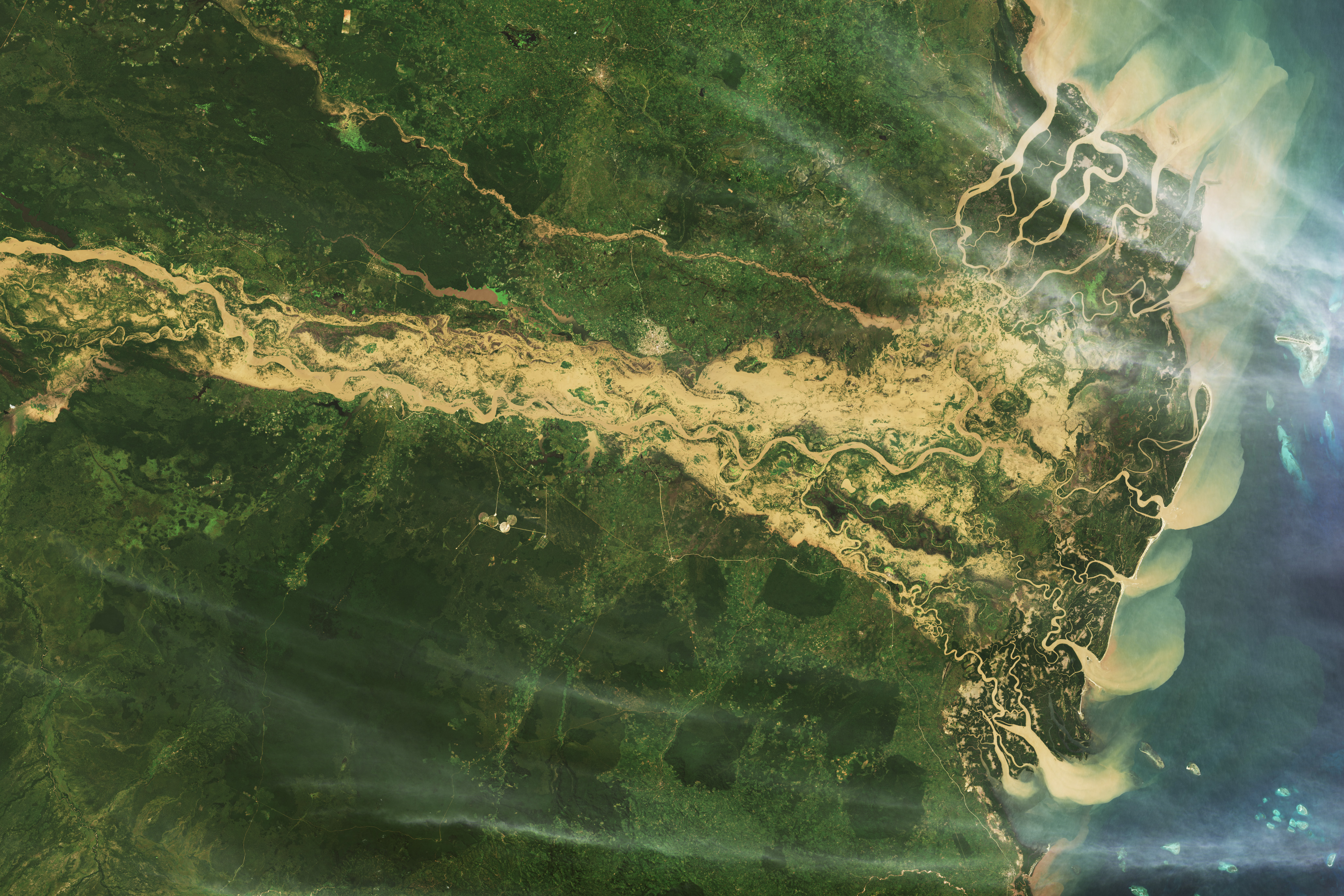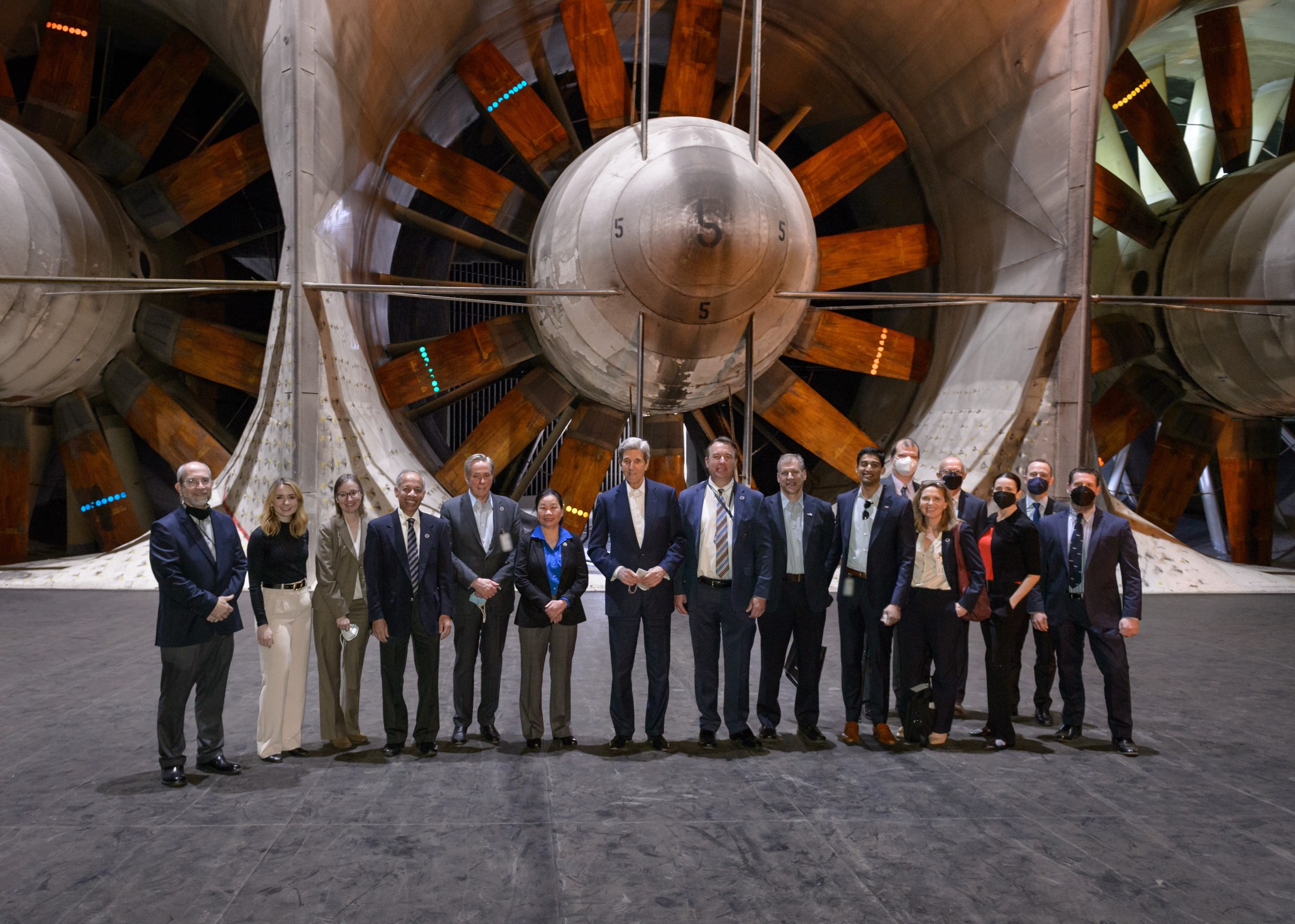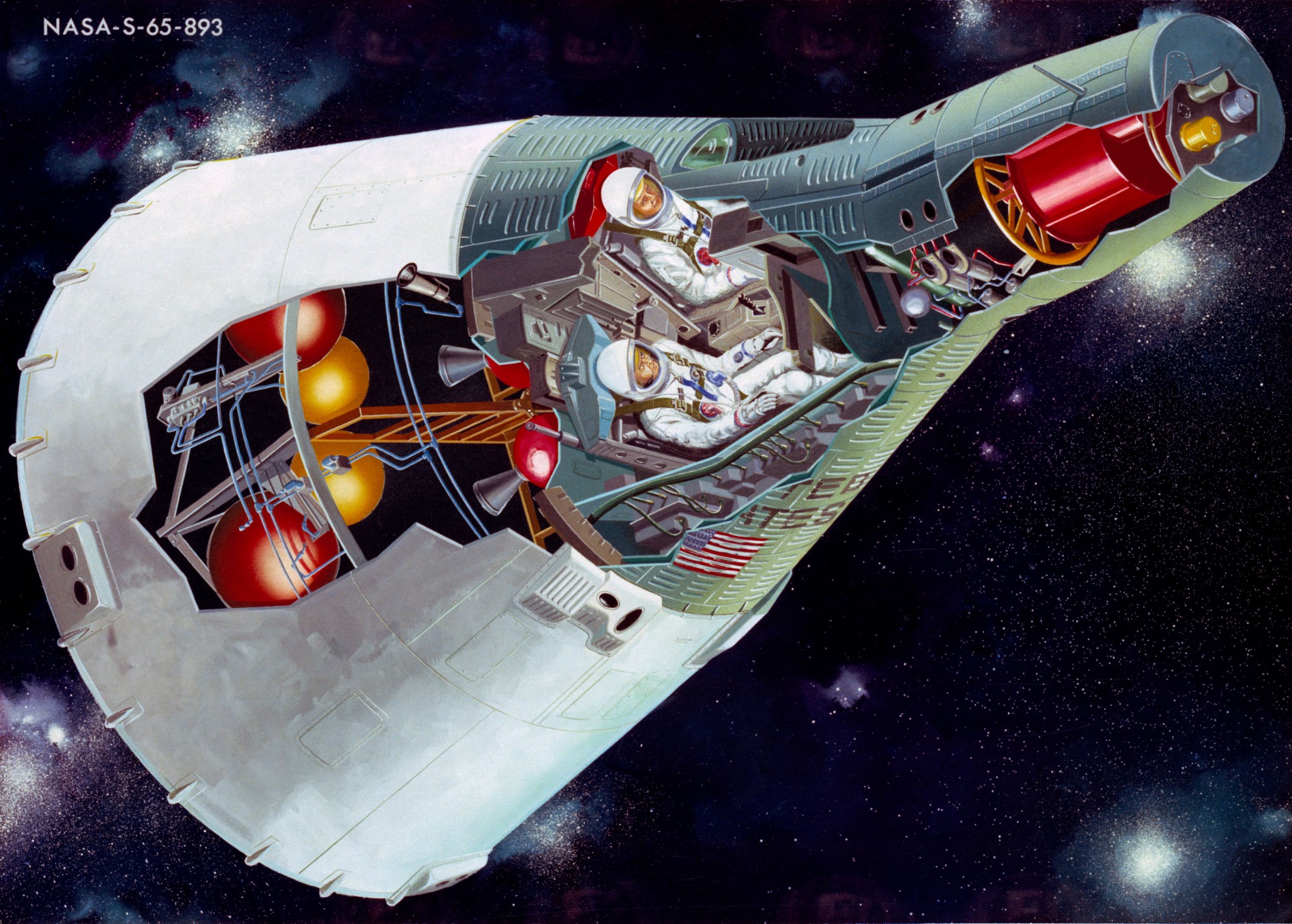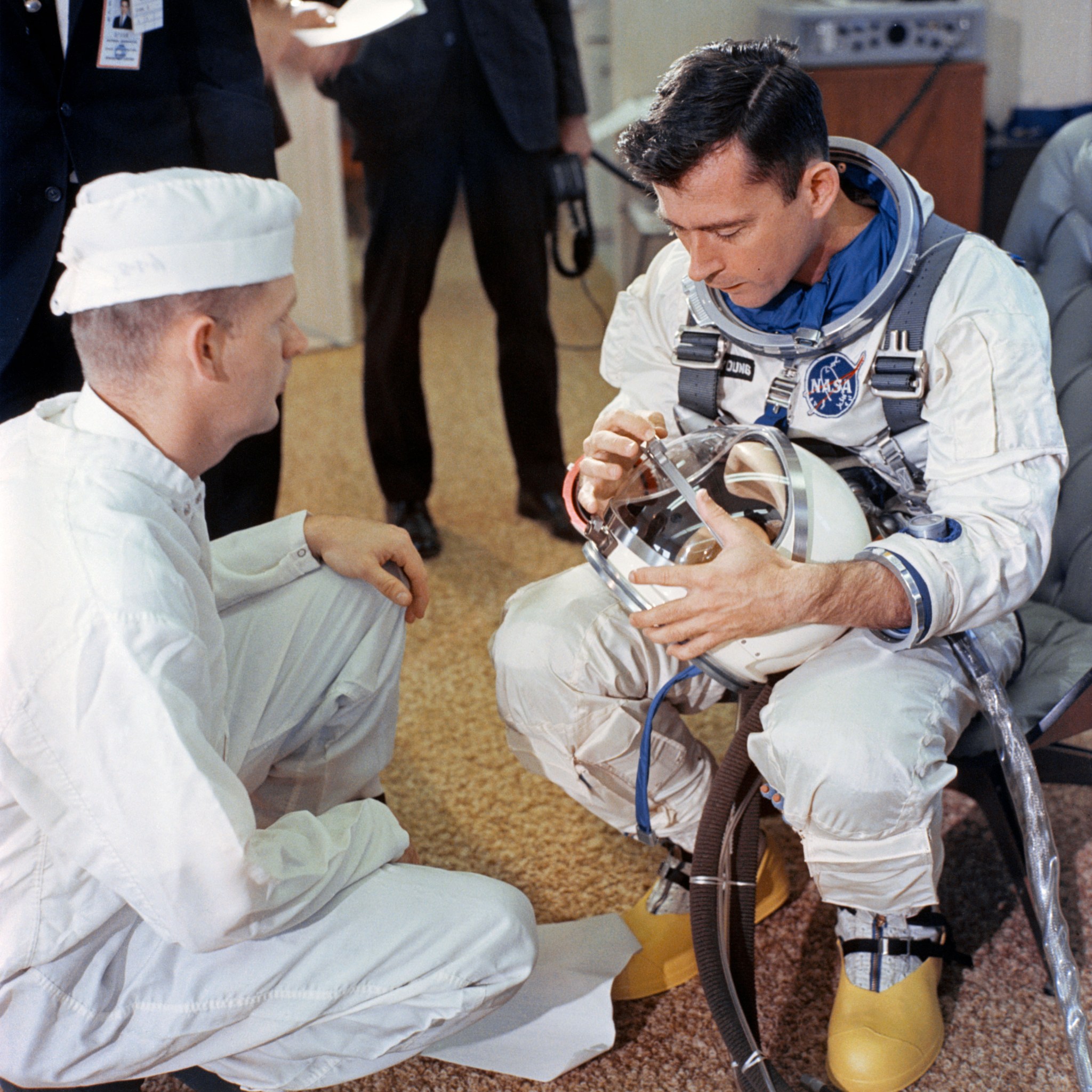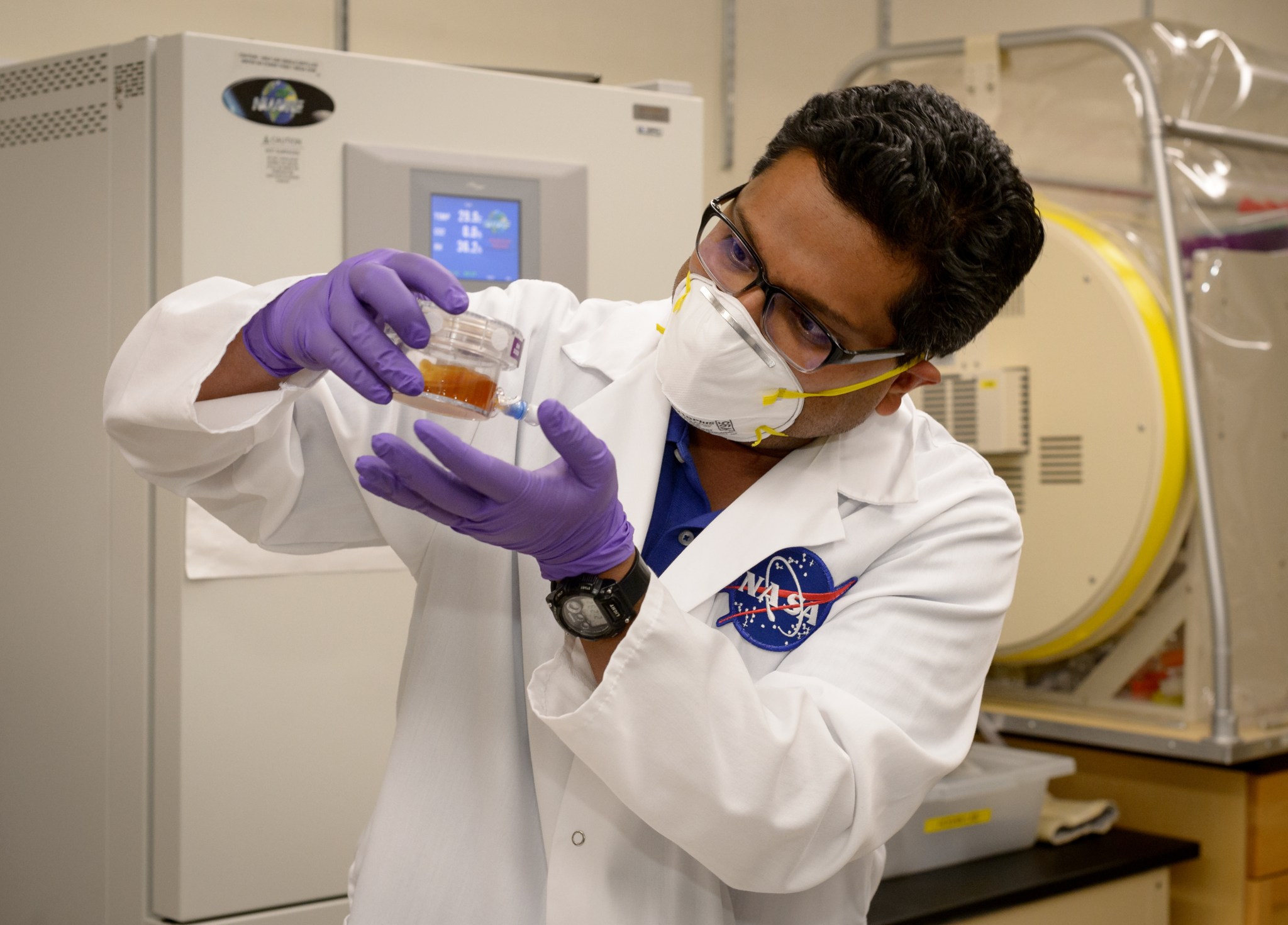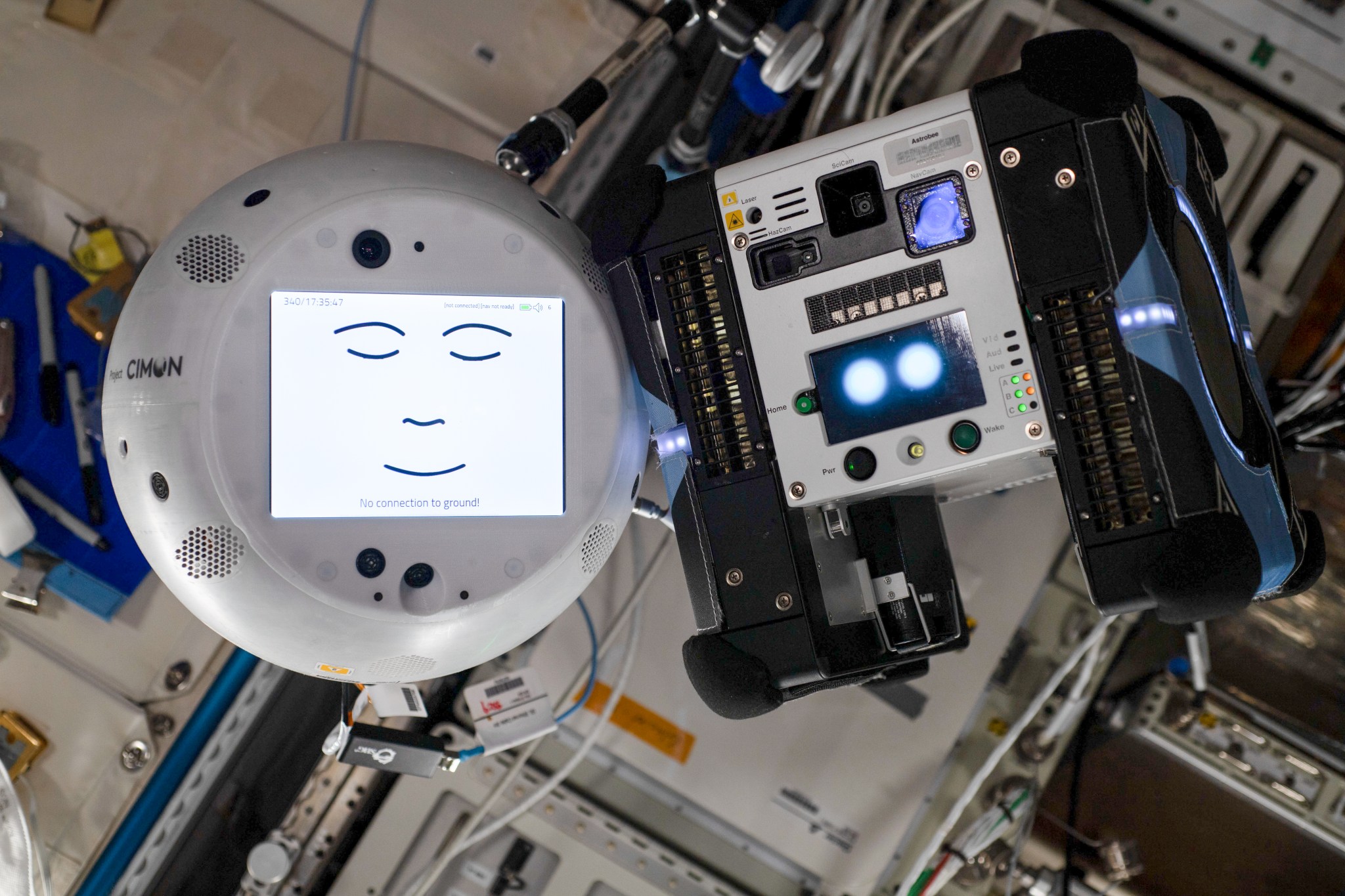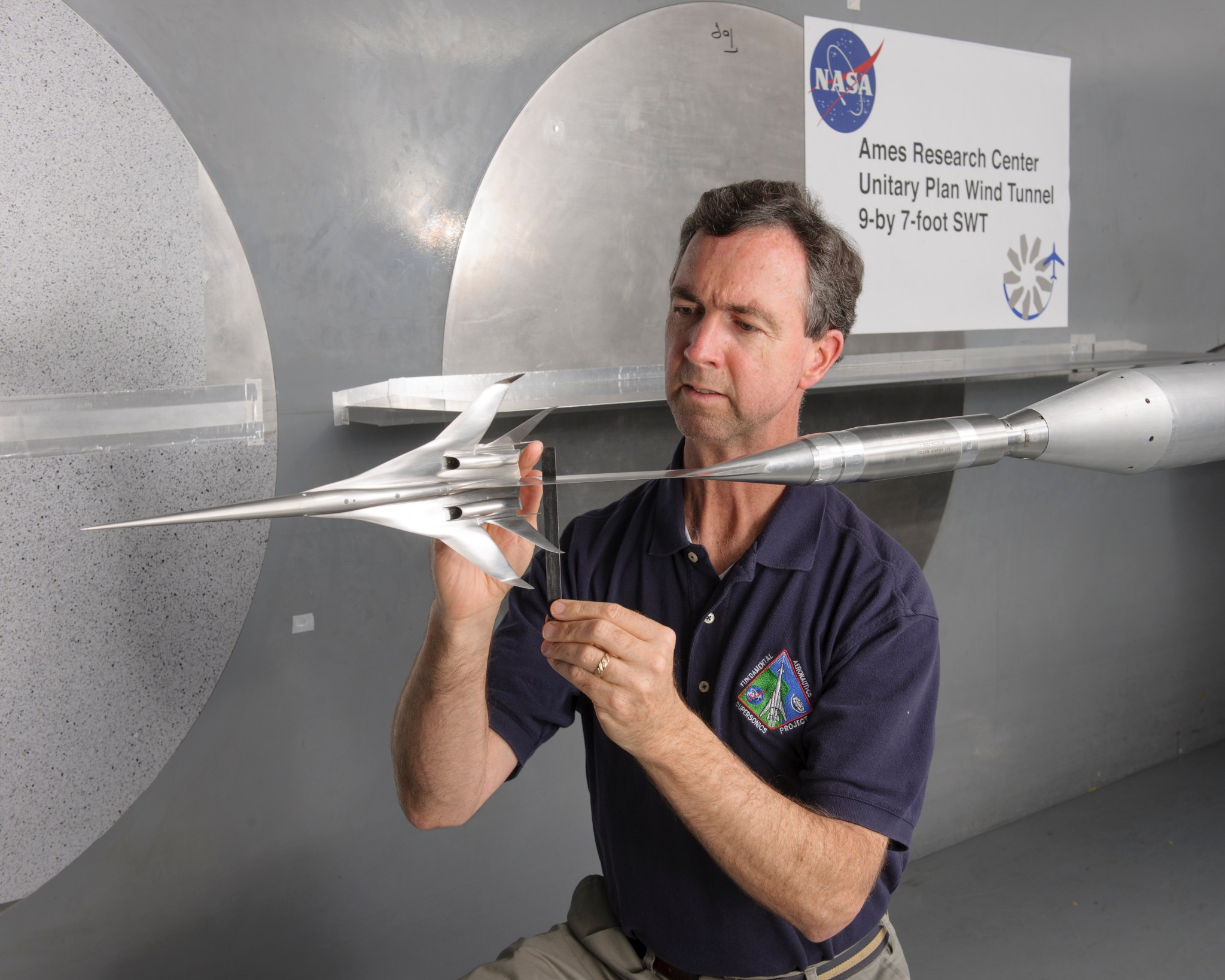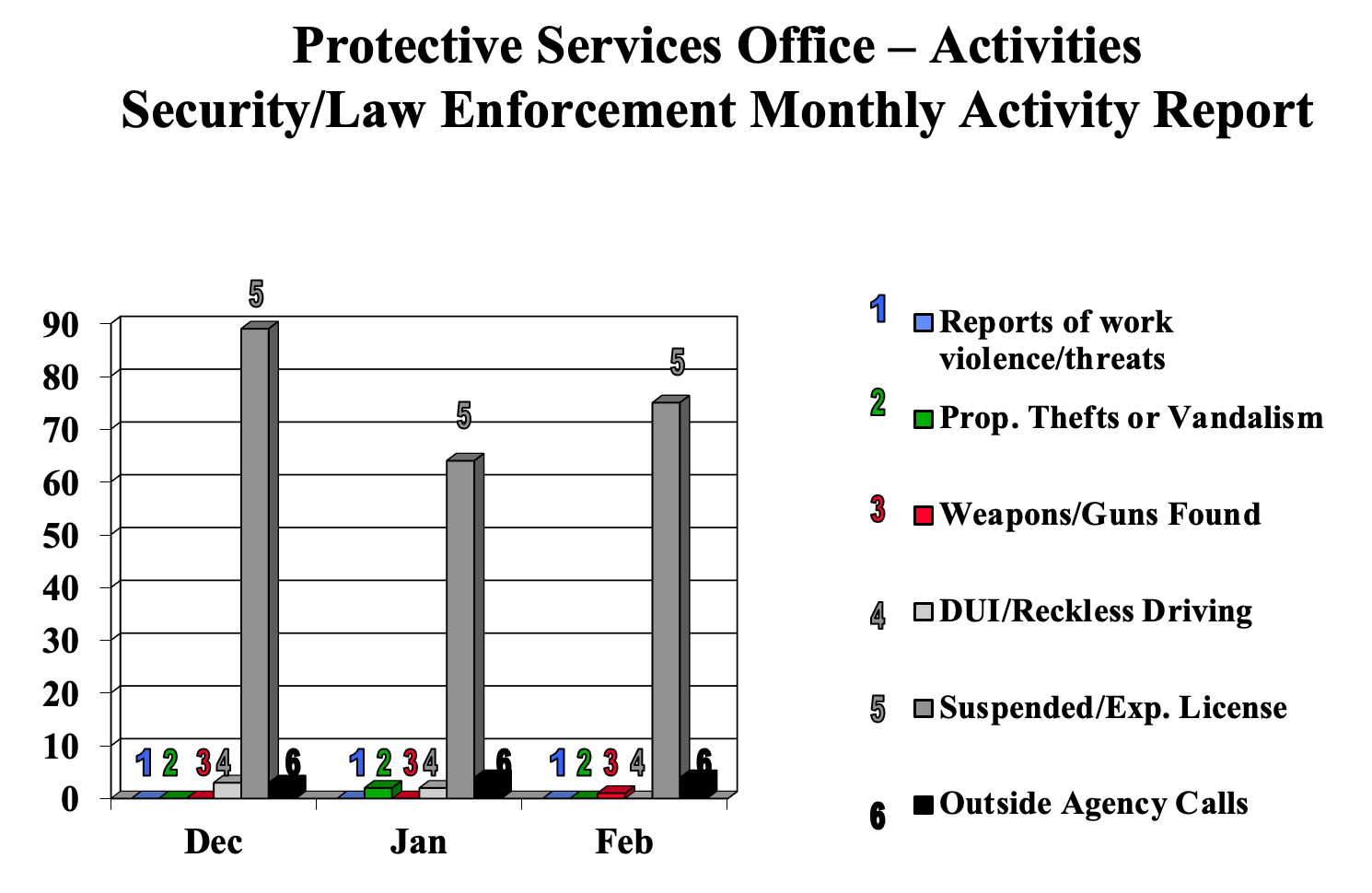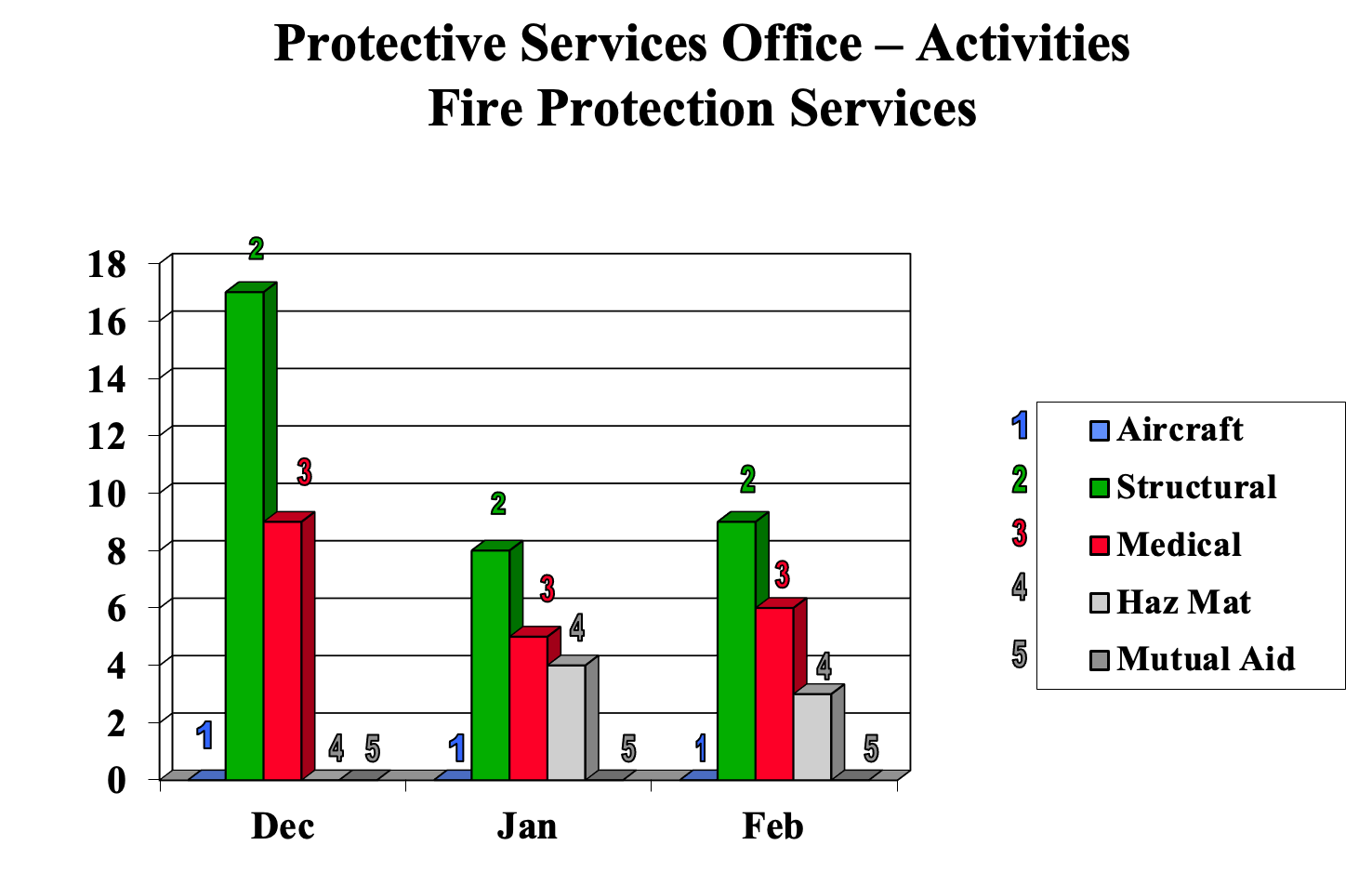Climate Envoy John Kerry Visits NASA Ames to Discuss Climate and Innovation
by Abigail Tabor
On March 8, U.S. Special Presidential Envoy for Climate with Secretary John Kerry toured Ames’ National Full-Scale Aerodynamics Complex (NFAC), the largest wind tunnel in the world. The unique facility is located at Ames and is operated by the U.S. Air Force. The tunnel’s test section measures 80 by 120 feet, and its airflow is driven by six enormous fans, seen here below, each 40 feet in diameter.
During the visit to Ames, Secretary Kerry learned about ways the NFAC can support industry as they develop new wind turbine technologies and other climate-related innovations.
The NASA Earth Exchange, a big-data collaborative project that uses the agency’s supercomputers at Ames, also was discussed, along with the center’s expertise in using aircraft – both crewed and uncrewed – to study and monitor the climate with Earth-observation instruments, many built at Ames or with Silicon Valley industry partners.
Contraband Corned Beef and the Early Days of Space Biology: the Gemini III Mission
by James Anderson
The Gemini III mission carried two remarkable firsts: an astronaut’s smuggled sandwich and NASA’s first fundamental space biology experiment in orbit.
The first corned beef sandwich to orbit Earth was smuggled aboard Gemini III on March 23, 1965. As contraband unapproved for flight by NASA, pilot John Young had hidden the sandwich in a pocket of his spacesuit shortly before the launch. Around two hours into the almost five-hour long flight, he offered some to the commander of the mission, Gus Grissom, who accepted the rye bread and preserved meat gift. The exchange over the sandwich lasted less than a minute and ended with Grissom putting the unfinished sandwich away in his own spacesuit pocket so the breadcrumbs that were breaking off would be less likely to float behind an instrument panel or into one of the astronaut’s eyes.
The approved food for the flight, meanwhile, was kept in a box next to Grissom. That box contained items like cubed food covered in a layer of gel, preventing the kind of crumb mess that quickly became obvious with the sandwich. Also on the menu for the short flight were more mundane courses like rehydrated applesauce, which the astronauts enjoyed while remarking that there was no pork chop to go with it.
In a separate box near the food was a canister containing sea urchin eggs, Arbacia punctulata. These eggs were not the kind of roe that appears on menus at sushi restaurants and were not intended for consumption. Instead, the canister containing the eggs represented a lesser-known milestone in NASA history: the agency’s first fundamental space biology experiment in orbit.
What we today call space biology – the study of fundamental mechanisms of life, such as metabolism and growth, and how they’re affected by space and spaceflight – traces its NASA roots to the very first years of the agency’s existence. High-altitude balloons and rockets had already carried some species to the edge of space and just beyond, before Project Mercury. Then, the Mercury flights included biomedical investigations into astronaut physiology, while Project Gemini incorporated fundamental biology experiments into the agency’s human spaceflight missions.
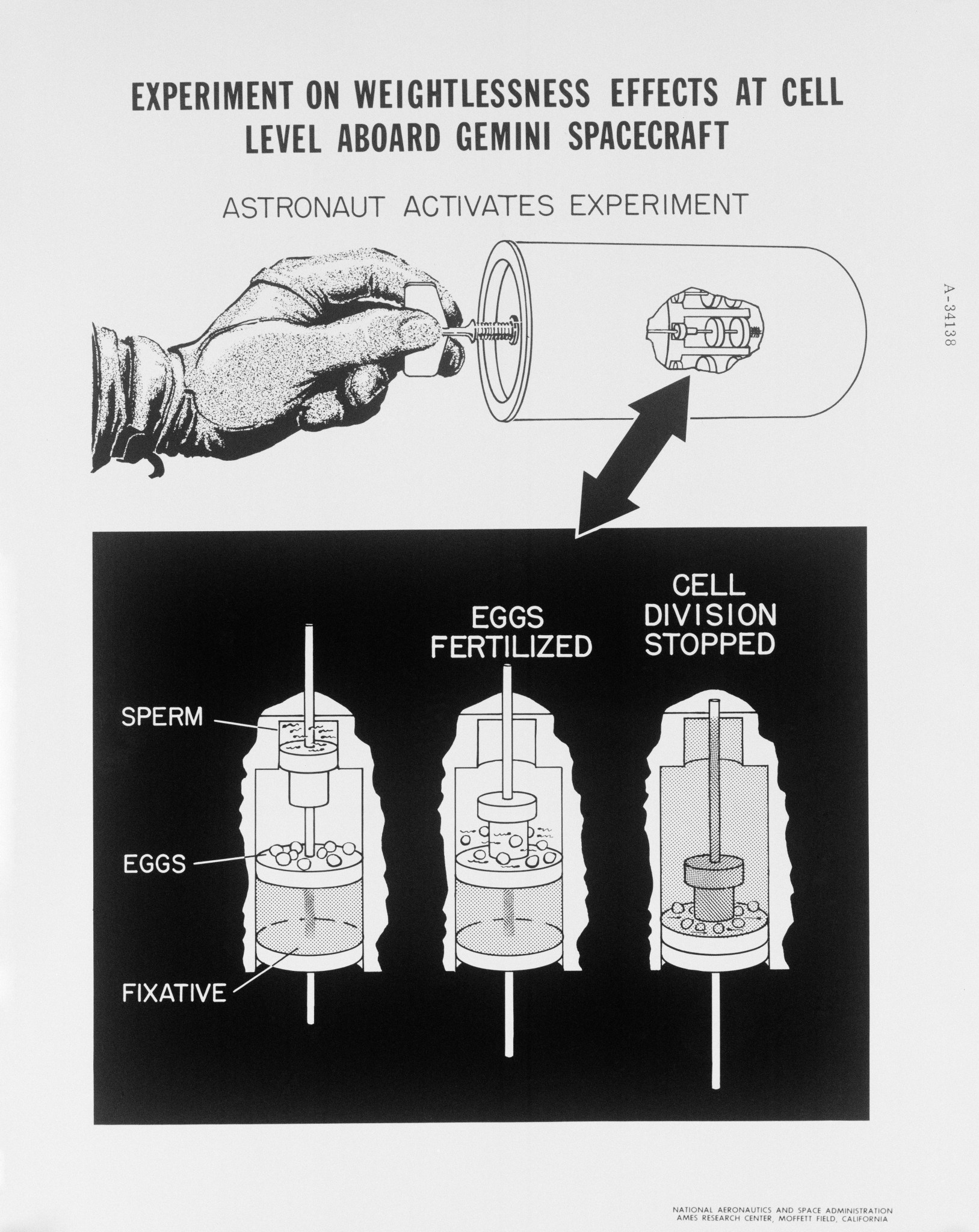
Gemini III was the first crewed mission of the program that tested many new capabilities in space essential for the success of Apollo, such as rendezvous and docking in orbit around Earth, perfecting re-entry and landing methods, and shaping our understanding of the effects of longer duration spaceflight. Over the course of the Gemini missions, astronauts performed 25 biomedical experiments, some of which were modified or repeated up to three times on different flights. Of the 13 unique experiments flown, the astronauts themselves were the test subjects in all but three cases where non-human payloads were used. In addition to the sea urchin eggs, frog eggs and bread mold also were studied. The tests on the astronauts often required a strictly controlled diet before and during the mission to assess how human physiology would respond to spaceflight. Such diet restrictions did not apply to Gemini III, so a few bites of the sandwich would not have disrupted any of the planned experiments.
What did disrupt the sea urchin experiment involved Grissom’s exuberance when turning the handle on the canister to initiate the fertilization followed by a fixative solution at planned intervals during the flight. The handle broke, so the experiment’s objectives were not achieved. The canister was redesigned, frog eggs were substituted, and the new experiment flew on Gemini VIII and then Gemini XII. By the end of the program, it had been demonstrated that cell division could occur in microgravity without detrimental effects attributable to the lower gravity environment.
Since the Gemini sea urchin and frog egg experiments, NASA has continued its research in space biology. On the final Apollo mission, mice joined the astronauts to study the effects of deep space radiation. Now, almost 50 years after Apollo 17, the first launch of the Space Launch System rocket for the Artemis I mission will carry among its secondary payloads the BioSentinel mission. The mission builds upon decades of fundamental space biology research aboard the space shuttle, the International Space Station, balloons, and small satellites – all within low-Earth orbit. BioSentinel has developed a biosensor instrument to detect and measure the impact of space radiation on living organisms over long durations – this time, beyond low-Earth orbit in deep space. Rather than sea urchin eggs or frog eggs, the mission will use yeast to address strategic knowledge gaps related to the biological effects of space radiation. And, since the mission is uncrewed, no astronaut will have the opportunity to bring an unauthorized sandwich along for the ride.
A Fresh Take: NASA BioNutrients for Future Artemis Missions
by Gianine Figliozzi
Dark leafy greens and vibrant hued root vegetables, such as carrots and sweet potatoes, are rich in nutrients essential for health. But some vitamins, even those provided in the form of nutritional supplements, lack the shelf-life needed to span multi-year human missions to Mars, as envisioned by NASA’s Artemis program. Planning ways to supply astronauts with vital nutrients for long-duration missions may require making or growing it in space. NASA’s BioNutrients experiment is testing technology to do just that.
BioNutrients is more than halfway through a five-year trial aboard the International Space Station. The experiment, developed by scientists at NASA Ames, assesses the stability and performance of a hand-held system to manufacture fresh vitamins on-demand in space. Astronauts are not consuming the nutrients during this study, but the products are intended to be safe to eat.
BioNutrients test units, called production packs, contain specially prepared microorganisms, in this case yeast, that churn out vitamins – beta carotene and zeaxanthin. Astronauts start the production of nutrients by grabbing a pack, which is stored at room temperature, adding water, shaking to mix the contents, and warming the packs in an incubator – a device that controls environmental conditions such as temperature.
Roughly once a year, a set of production packs that were stored on the space station return to Earth aboard a SpaceX Cargo Dragon resupply spacecraft. The BioNutrients team processes these packs in their laboratory at Ames, along with an additional set of packs that were never flown in space. On the same day as the ground experiments, an astronaut performs production runs aboard the orbiting laboratory. This helps the researchers see how well the system performs in space compared to on the ground. Here, Aditya Hindupur, lead scientist for the BioNutrients experiment, inspects one of the production packs after removing them from an incubator in a lab at Ames.
Even after 33 months in space, the yeast are visibly producing the orange-colored beta carotene and zeaxanthin nutrients. When samples from in-space production runs return to Earth, the BioNutrients team further analyzes them to measure the yeast’s growth and the nutrients they produced. The team examines how the packaging and the growth media, or “yeast food,” perform. Additionally, the team assesses how easy it is for the crew to operate the system as well as keep an eye on microbial contaminants to ensure the nutrients are safe for human consumption.
Robot Colleagues Meet Aboard the International Space Station
by Arezu Sarvestani
The Astrobee and Project CIMON (Crew Interactive MObile companioN) robots had their first photo shoot in space after more than two years of working separately aboard the International Space Station. These free-floating helpers come from different countries and have unique functions, but they share a mission to assist astronauts, support station operations, and enable research that will take humans to the Moon and on to Mars.
Team Astrobee includes three identical robots differentiated by the colors on their robot shells – the blue one in this photo is named Bumble. These cube-shaped robots can operate autonomously or via remote control by operators on the ground to perform tasks such as taking inventory or monitoring the environment aboard the station. The Astrobees were funded by the agency’s Game Changing Development program and designed and built at NASA’s Ames Research Center in California’s Silicon Valley. Bumble first launched to the space station in 2019 with Honey, the yellow Astrobee. Their green sister, Queen, joined the crew aboard the station later that year.
Project CIMON, which was commissioned by the German Space Agency at DLR and developed by Airbus and IBM, is a project providing the first artificially intelligent assistant aboard the orbiting laboratory. This voice-controlled robot is designed to act as a hands-free database, computer, and camera to support research. The teams behind Project CIMON also hope to study the platform’s potential to help reduce astronaut stress associated with isolation or group dynamics by providing social assistance. The Project CIMON free flyer launched to the space station in June 2018.
Ames’ Contributions to the X-59 Quiet SuperSonic Technology Aircraft
by Rachel Hoover
A faster-than-sound airplane generates sonic thumps so quiet that people on the ground might not hear anything at all.
Not much has changed in commercial aircraft design and technology for the last 50 years. That’s about to … well … change thanks to efforts to design future commercial aircraft capable of hushing sonic booms to a mere thump as they fly faster than the speed of sound.
Supersonic travel is as cool as it sounds. Imagine flying aboard an aircraft cruising faster than the speed of sound, cutting your coast-to-coast travel time in half. Currently such a thing only exists in the dreams of aircraft designers. And while no passenger will ride aboard NASA’s X-59 Quiet SuperSonic Technology, or QueSST, the experimental aircraft is bringing the agency ever closer to making the quiet commercial supersonic travel over land a reality.
NASA’s Ames Research Center in California’s Silicon Valley has decades of experience researching supersonic flight, including numerous efforts under the Commercial Supersonic Technology project, or CST – a lot of which has gone into the unique design of the X-59. These efforts cover several areas related to supersonic research, including the use of cutting-edge visualization technology to study shockwaves, and use of unique wind tunnels, supercomputing facilities, and systems engineering expertise. These are but a few of the many areas of research into realizing the goal of CST and of the X-59 QueSST, which includes the eventual demonstration of quiet supersonic flight over land.
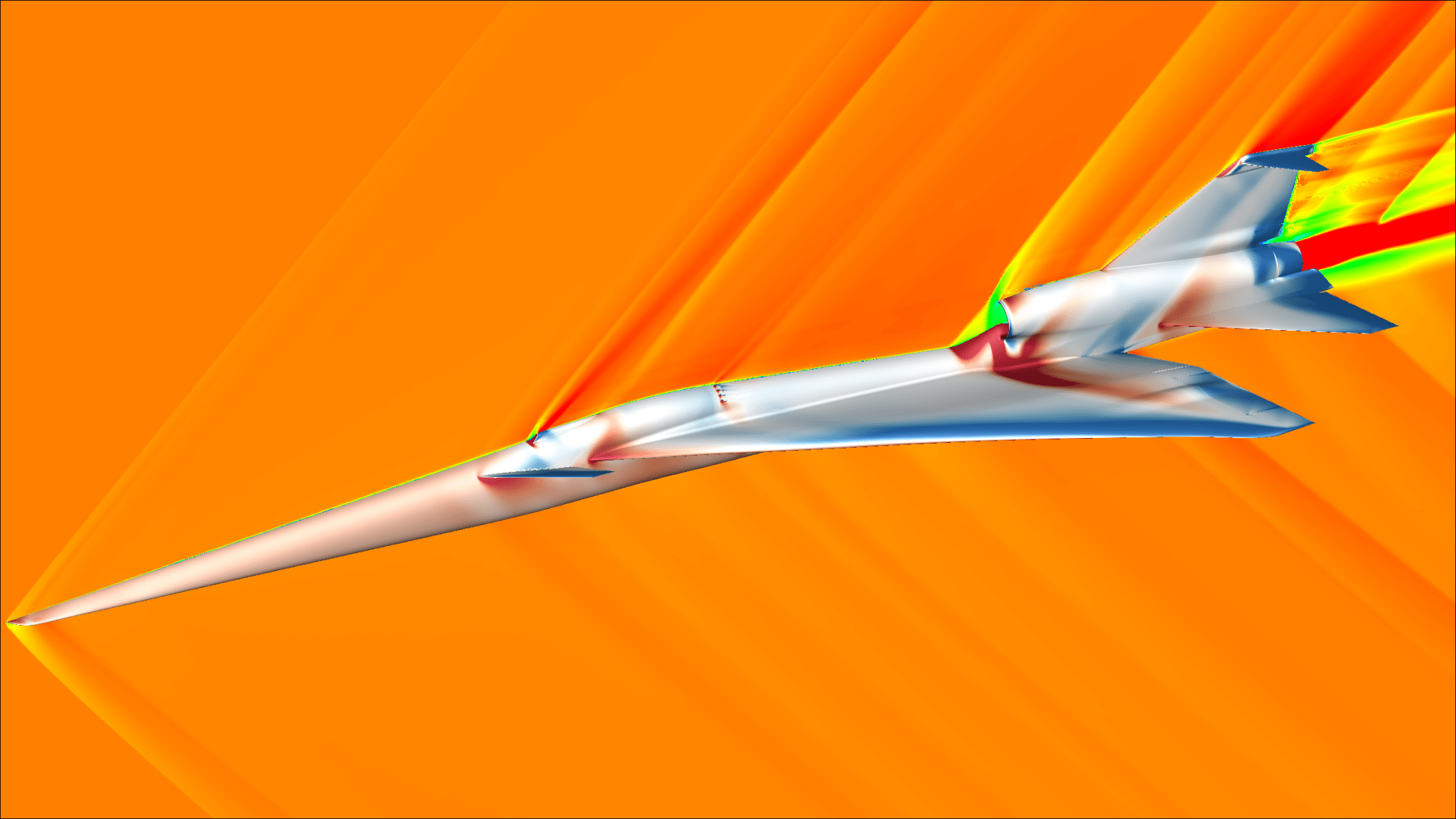
Computational Fluid Dynamics
As Lockheed Martin Skunk Works in Palmdale, California, finalized the X-59 airplane’s design, they ran their ideas using an Ames-developed high-resolution, 3D simulation software on multiple supercomputers at Ames – the Pleiades, Electra, and Endeavour. Recent improvements in the software have enabled engineers to get simulation data about the flight characteristics and noise levels even faster – sometimes five times as fast.
With no X-59 flight data – yet – computer simulation is the next best thing to build confidence in the predictions for its supersonic performance. Teams at Ames and NASA’s Langley Research Center in Hampton, Virginia, worked together to ensure that multiple software codes would make similar predictions about how loud the X-59 will be in different environments. For example, they know the boom’s loudness changes based on the cloud cover and humidity of the areas below a flight path, and can give the pilot information in the cockpit that can help guide the aircraft to areas where the boom may be quieter. Computational fluid dynamics simulations also create visualizations of the X-59 aircraft concept and help researchers determine which features of the aircraft generate shockwaves that contribute to the sonic thump sound below the aircraft.
NASA is working closely with Lockheed Martin to create a large database of computational fluid dynamics simulations to verify the aircraft’s supersonic performance. The database includes simulations for all possible combinations of settings that a pilot uses to control the aircraft and the flight conditions that may be encountered. This database is crucial for supplying data for a flight-planning tool that is being used to assist and teach pilots how to fly the X-59, before it even flies. From there, researchers can determine the best flight conditions to reduce noise when they begin piloted test flights over select U.S. cities. These flights also will provide opportunities to collect, verify, and validate data about community responses. NASA will share the data with U.S. and international regulators which will use it when considering new sound-based rules for supersonic flight over land. New rules could enable new commercial cargo and passenger markets in faster-than-sound air travel.
Wind Tunnel Testing
Some researchers think of computational fluid dynamics as a virtual wind tunnel test. Luckily, Ames has run thousands of hours of supersonic tests using actual wind tunnels since the 1950s. The 9- by 7-foot Supersonic Wind Tunnel facility is part of the Unitary Plan Wind Tunnel complex at Ames where generations of commercial and military aircraft and NASA space vehicles, including the space shuttle, have been designed and tested.
One way to make sure the X-59 will work as intended is to “fly” smaller versions of the real thing in a wind tunnel. While supersonic air flows over precisely crafted small models, engineers can take measurements of the pressure waves and be sure the plane behaves as expected. Some models measured as little as five inches long, while others stretched to more than six feet in length.
But even in the 21st century, with all our technical know-how, measuring supersonic airflow over an airplane model in a wind tunnel is an uncertain process. Even running the same test with the same model can produce slightly different results on different days because the airflows in the tunnels are not perfect. Put the model in another wind tunnel and you’ll get a slightly different version of the data.
This is why Ames continues to contribute its expertise to wind tunnel operations in support of the X-59. Ames contracted a model-building company, Tri Models, Inc. of Huntington Beach, California, to design and fabricate a small 19″-long model of the X-59 for sonic boom wind tunnel testing. The first test of this model took place in 2021, in NASA’s Glenn Research Center‘s 8- by 6-Foot Supersonic Wind Tunnel in Cleveland. The second test will take place in 2022 in the supersonic wind tunnels at the Japan Aerospace Exploration Agency, or JAXA, under a recently-announced collaboration, which will allow researchers to compare results from tests of the same small-scale model.
Systems Engineering
Systems engineers are responsible for looking at all of the parts of a complex system and then figuring out how these parts can be interconnected. In short, they are looking at the big picture. Systems engineers are responsible for the design, setting and tracking the requirements, implementation and evaluation, technical management, operations, and end-life of a system. Without them, a project like X-59 won’t leave the ground, much less the drawing page.
At Ames, systems engineers are focused on ensuring that the different systems such as the life support subsystem – that provides the pilot with oxygen – and the crew escape system – that would eject the pilot seat in case of an emergency – as well as systems for controlling the distribution of power and recording data are “talking” to each other and working as intended. Additionally, mass, airworthiness, and qualification of flight components are managed and tracked by systems engineers at Ames.
Test Component Manufacturing
Engineers at Ames manufactured specialized mounts to test some of the X-59 Life Support Systems flight components one at a time in specialized test chambers at the Environmental Laboratory at NASA’s Armstrong Flight Research Center in Edwards, California. The mounts enabled engineers to test how well Life Support System components performed under the vibration, pressures, and temperatures that the aircraft could experience. These parts are not on the final aircraft, but enabled engineers to qualify components for flight.
Milestones:
- NASA plans to deliver results of the community overflights to the International Civil Aviation Organization and Federal Aviation Administration in 2027. With that information in hand, regulators will be able to decide if a change should be made in rules that prohibit supersonic flight over land – a decision that would be expected in 2028
- NASA plans to fly the X-59 QueSST over select communities to gather information about how the public perceives the quiet noise the X-59 is designed to produce (early 2024)
- NASA will conduct acoustic validation flights (2023)
- Major ground testing will conclude in early 2022, leading to a target date for first flight (late 2022)
- NASA and JAXA agreed to take independent wind-tunnel measurements of the same small-scale model of the X-59, and compare results (2022)
- NASA and Lockheed Martin completed the X-59 assembly (2021)
- Wind tunnel testing at Glenn (September 2021)
- Construction continued in earnest as the project passed its Critical Design Review in October 2019 and another key program management review (December 2019)
- The initial machined parts were delivered to Lockheed Martin Skunk Works (November 2018)
- Quiet Supersonic Flight series research campaign took place over Galveston, Texas (November 2018)
- NASA completed the preliminary design review of its QueSST aircraft design. QueSST is the initial design stage of NASA’s planned X-59 experimental airplane (June 2017)
- NASA selected a team led by Lockheed Martin Aeronautics Company of Palmdale, California, to complete a preliminary design for QueSST. The work was conducted under a task order against the Basic and Applied Aerospace Research and Technology (BAART) contract at Langley. The Lockheed Martin team includes subcontractors GE Aviation of Cincinnati and Tri Models Inc. of Huntington Beach, California. (February 2016)
- NASA began a series of supersonic wind tunnel tests of Lockheed Martin’s and Boeing’s Phase I supersonic aircraft concepts using Ames’ 9- by 7-Foot Supersonic Wind Tunnel as part of the project’s Experimental Systems Validations for N+2 Supersonic Commercial Transport Aircraft effort (2010 through 2013)
Collaborators:
Taken together, this mission work is spread across three projects within NASA’s Aeronautics Research Mission Directorate. They include the Commercial Supersonic Technology project managed out of NASA Langley, the Flight Demonstrations and Capabilities project managed out of Armstrong, and the Low Boom Flight Demonstrator project, responsible for the X-59 aircraft itself, managed out of NASA Headquarters in Washington.
Elements of NASA’s Low-Boom Flight Demonstration mission are organized within two of the agency’s aeronautics programs — the Advanced Air Vehicles Program and the Integrated Aviation Systems Program — and overseen by a mission integration office whose members span both programs and all four of NASA’s aeronautical research field centers: Langley, Glenn, Ames, and Armstrong.
X-59 also relies on the expertise of international collaborators at JAXA as well as contractors here at home, including Lockheed Martin, which is constructing the aircraft at its Skunk Works Facility in Palmdale, California, and a team of subcontractors at GE Aviation of Cincinnati and TriModels Inc. of Huntington Beach, California.
Bracing for Fuel-Efficient Flight
by Abigail Tabor
A new kind of passenger aircraft that could use significantly less fuel?
Yes, please!
But the Transonic Truss-Braced Wing aircraft, or TTBW, the concept design shown here inside a NASA wind tunnel, is quite a departure from “business as usual.” So, plenty of exploratory testing is a must to predict how it will perform in flight.
This scale model represents only half the aircraft to allow the tunnel to hold a bigger model. That way, it can be packed with hundreds of sensors embedded all over its surface to measure different factors, including pressure forces, when the air starts flowing.
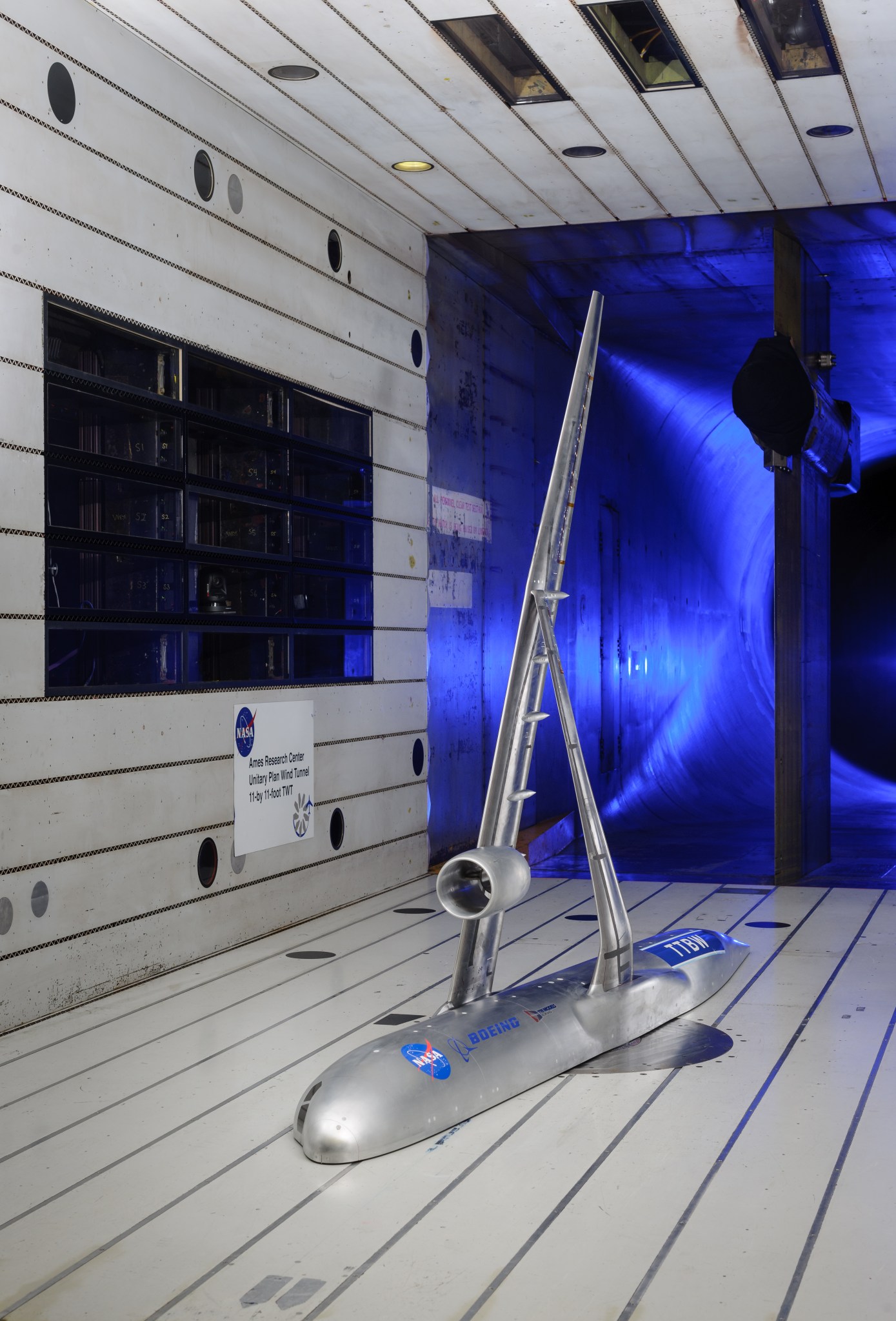
That was necessary for a test recently completed in the Unitary Plan Wind Tunnel at NASA’s Ames Research Center in California’s Silicon Valley. It was looking at buffet, a type of vibration that can affect aircraft flying at high speeds. Buffet is caused by the rapidly changing pressure forces of air flowing unsteadily over the wings.
The TTBW’s extra-long, thin wings stabilized by diagonal struts should make it lighter than a traditional airliner, and their shape will create less drag in the air. The plane will burn less fuel – likely an extra 8-10 percent less than aircraft with similarly advanced technologies but a traditional wing design.
The researchers designing the TTBW, a collaboration between NASA and Boeing, will use the data from the recent test to find the upper limits the aircraft can perform at – in terms of combinations of factors like speed and altitude – before the vibrations caused by buffet become excessive.
This will help them better understand how their plane will really fly and how well their tools are predicting the vehicle’s performance. Where computer simulations may be less accurate capturing certain effects, like buffet, wind tunnel tests can clarify how well they’re predicting the flow of air over this unusual truss-braced configuration.
If any gaps are identified in the predictions, the TTBW team will continue studying them. And that will give its designers every confidence in their aircraft when it takes off for its first fuel-efficient flights. If successful, this technology could potentially be used for new aircraft in the 2030s.
The TTBW concept is part of an ongoing initiative by NASA, industry partners, and academia to make the future of aviation more environmentally friendly through the Sustainable Flight National Partnership.
















